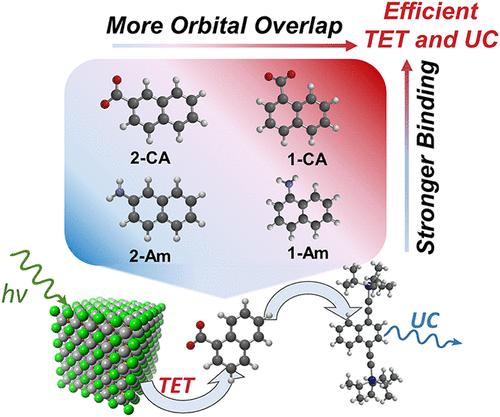通过键电子耦合和强配体结合促进了CsPbBr3量子点蓝光到紫外光子的上转换
IF 18.2
1区 材料科学
Q1 CHEMISTRY, PHYSICAL
引用次数: 0
摘要
CsPbBr3量子点(QDs)作为蓝-紫外三重态湮灭上转换(TTA-UC)的三重态增敏剂已经引起了人们的兴趣,它可以用来驱动光催化和高分辨率3D打印等工艺。为了促进上转换,与QD结合的分子发射器以三重态激子的形式接受能量,并将其传递给溶液中参与ta - uc的分子。在这里,我们研究了将萘基配体连接到CsPbBr3量子点上的不同结合基团如何影响其作为传递体的性能。我们发现萘胺配体与CsPbBr3量子点结合较弱,阻止它们作为有效的传递体发挥作用。相比之下,1-和2-萘酸配体都能实现蓝色到紫外线的TTA-UC,其中1-萘酸表现出更强的性能,阈值强度降低50%。这源于通过键耦合的改进,这是由于几何形状的细微差异促进了三重态能量传递。我们的研究结果强调了在设计量子点三重态发射机时,结合和轨道相互作用的重要性。本文章由计算机程序翻译,如有差异,请以英文原文为准。

Through-Bond Electronic Coupling and Strong Ligand Binding Facilitate Blue-to-UV Photon Upconversion by CsPbBr3 Quantum Dots
CsPbBr3 quantum dots (QDs) have garnered interest as triplet sensitizers for blue-to-UV triplet–triplet annihilation upconversion (TTA-UC), which can be leveraged to drive processes, such as photocatalysis and high-resolution 3D printing. To facilitate upconversion, molecular transmitters bound to a QD accept energy in the form of a triplet exciton and pass it to molecules in solution that engage in TTA-UC. Here, we investigated how different binding groups affixing naphthalene-based ligands to CsPbBr3 QDs impact their performance as transmitters. We find that naphthylamine ligands bind weakly to CsPbBr3 QDs, preventing them from functioning as effective transmitters. In contrast, 1- and 2-naphthoic acid ligands each enable blue-to-UV TTA-UC, with 1-naphthoic acid showing stronger performance with a 50% lower threshold intensity. This arises from improved through-bond coupling due to a slight difference in geometry that facilitates triplet energy transfer. Our results highlight the importance of binding and orbital interactions when designing QD triplet transmitters.
求助全文
通过发布文献求助,成功后即可免费获取论文全文。
去求助
来源期刊

ACS Energy Letters
Energy-Renewable Energy, Sustainability and the Environment
CiteScore
31.20
自引率
5.00%
发文量
469
审稿时长
1 months
期刊介绍:
ACS Energy Letters is a monthly journal that publishes papers reporting new scientific advances in energy research. The journal focuses on topics that are of interest to scientists working in the fundamental and applied sciences. Rapid publication is a central criterion for acceptance, and the journal is known for its quick publication times, with an average of 4-6 weeks from submission to web publication in As Soon As Publishable format.
ACS Energy Letters is ranked as the number one journal in the Web of Science Electrochemistry category. It also ranks within the top 10 journals for Physical Chemistry, Energy & Fuels, and Nanoscience & Nanotechnology.
The journal offers several types of articles, including Letters, Energy Express, Perspectives, Reviews, Editorials, Viewpoints and Energy Focus. Additionally, authors have the option to submit videos that summarize or support the information presented in a Perspective or Review article, which can be highlighted on the journal's website. ACS Energy Letters is abstracted and indexed in Chemical Abstracts Service/SciFinder, EBSCO-summon, PubMed, Web of Science, Scopus and Portico.
 求助内容:
求助内容: 应助结果提醒方式:
应助结果提醒方式:


